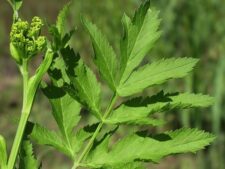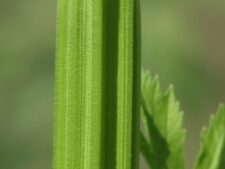
WILD PARSNIP
Pastinaca sativa
PARSLEY FAMILY (Apiaceae)
 Identification
Identification
- Flowering time - May, June, July
- Rare at Neale Woods - none at FF to date
- Yellow, flat-topped umbrella-like flower clusters
- Compound leaves with several pairs of leaflets plus a single one at the tip
- Stout, grooved stem
In its first year this biennial plant, an escapee from our gardens and a native of Europe, exists as a low rosette of compound leaves. The following year it develops a stout, smooth, grooved stem 2-5 feet tall (A,D). Leaves are pinnately compound with opposite, prominently toothed leaflets up to 6 inches long and an odd leaflet at the tip (C). The flat-topped flower cluster consists of several umbels (compound umbel) each consisting of many small, individual yellow to reddish flowers with 5 tiny petals whose tips are curled inward (B).
Grows in ditches, roadsides and waste places, flowering from May through July. It is rare at Neale Woods. The plant in the photos, taken at the lower end of Jonas Prairie, is the only one seen at either of our nature centers to date. More are expected because Wild Parsnip is on the march and is now abundant along I 80 well west of Des Moines, Iowa.
The sap of Wild Parsnip contains a chemical that increases sensitivity of the skin to sunlight causing a photodermatitis. A severe sunburn-like rash or even blistering of the skin is possible. Use caution when handling this plant and be sure to wear gloves and protective clothing.
The content of NatureSearch is provided by dedicated volunteer Naturalists of Fontenelle Forest who strive to provide the most accurate information available. Contributors of the images retain their copyrights. The point of contact for this page is: Neal Ratzlaff.



